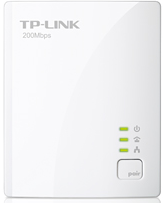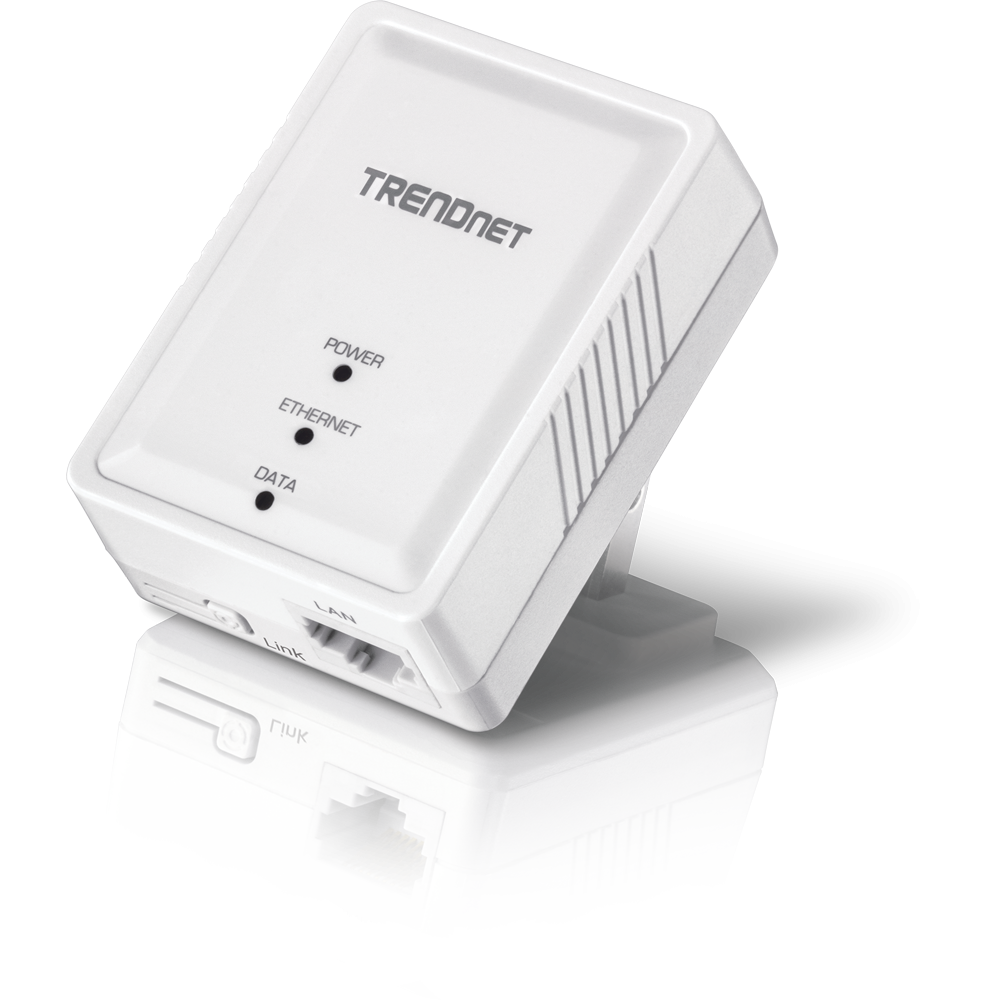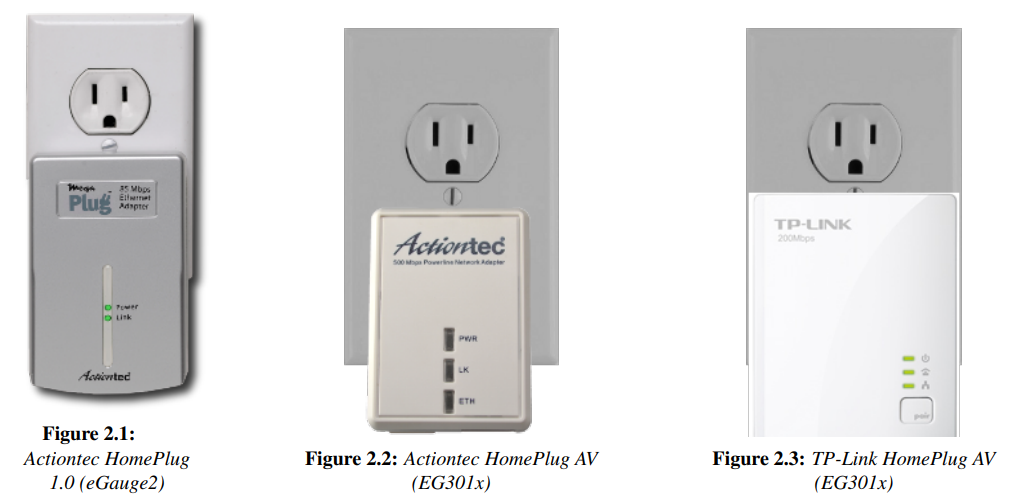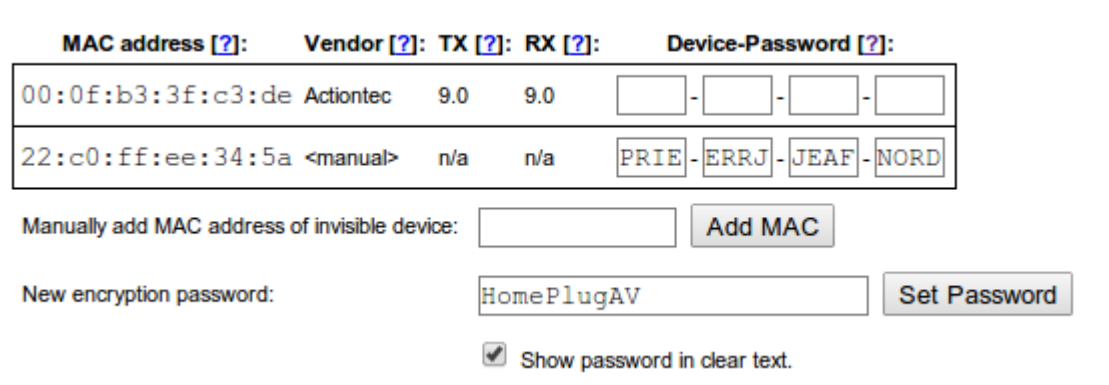| ### TRENDnet HomePlug AV (TPL-406E2K)  | |||
| **LED** | **Function** | **Typical Behavior** | **Other Behavior** |
| POWER | Indicates the adapter has power | Green light | No LED - no communication for too long or not receiving power |
| ETHERNET | Indicates an Ethernet line connection | On - live Ethernet line connected Blinking - sending/receiving Ethernet data | Off - may indicate an issue with network connectivity or a damaged Ethernet cable |
| DATA | Indicates presence of powerline communication | On - Powerline device connected Blinking - sending/receiving powerline data | Off - no connection to any HomePlug devices |
| ### TP-Link HomePlug AV (TL-PA2010)  | |||
| **LED** | **Function** | **Typical Behavior** | **Other Behavior** |
|  | Indicates the adapter has power | Green light | No LED - no Ethernet communication for too long or not receiving power |
|  | Indicates a connection with the eGauge or another HomePlug AV adapter | Blinking green when communicating with the eGauge | Off - no connection to any HomePlug AV devices |
|  | Indicates an Ethernet line connection | Blinking green light when transmitting data | Off - may indicate an issue with network connectivity or a damaged Ethernet cable |
| ### Actiontec HomePlug AV (PWR500/PWR200)
 | |||
| **LED** | Function | Typical Behavior | **Other Behavior** |
| PWR | Indicates the adapter has power | Green light | No LED - no Ethernet communication for too long or not receiving power |
| LK | Indicates a connection with the eGauge or another HomePlug AV adapter | Blinking red light when communicating with the eGauge | Blinking orange or green - possible connection with another HomePlug AV device Off - no connection to any HomePlug AV devices |
| ETH | Indicates an Ethernet line connection | Blinking green light when transmitting data | Off - may indicate an issue with network connectivity or a damaged Ethernet cable |
| ### HomePlug 1.0 HPE100T
 | |||
| **LED** | **Function** | **Typical Behavior** | |
| Power | Adapter has power and is connected to the eGauge or another HomePlug 1.0 device | Green light when active, blinking green light when transmitting data | Off - adapter is not receiving power, or cannot communicate to the eGauge |
| Link | Indicates an Ethernet line connection | Green when active, blinking green when transmitting data | Off - issue with network connectivity or a damaged Ethernet cable |
In new installations, pairing is optional but not required. The eGauge and HomePlug adapter should communicate out of the box. If they do not communicate, there is likely a distance or installation issue; pairing will not correct these issues.
The internal HomePlug MAC address may be different than the MAC address printed on the meter label. For pairing EG4xxx meters, use a MAC address one higher than the one printed on the label. The MAC address on the label is what the LAN will see; the "internal" address that is one higher is used on the powerline network.
### Contents [HomePlug Basics](#bkmrk-homeplug-basics) [ What is HomePlug and how is it used?](#bkmrk-what-is-homeplug-and) [ Technical And Environmental Considerations](#bkmrk-technical-and-enviro) [ How Secure is HomePlug Communication?](#bkmrk-how-secure-is-homepl) [Changing the HomePlug Encryption Key (pairing)](#bkmrk-changing-the-homeplu) [ Push Button Method (EG301x meters)](#bkmrk-push-button-method-%28) [ LCD Method (EG41xx meters)](#bkmrk-lcd-method-%28eg41xx-m) [ HomePlug Adapter Push Button Timing](#bkmrk-%C2%A0-11) [Push Button Pairing Process](#bkmrk-%C2%A0-15) [Pairing through the eGauge user interface](#bkmrk-pairing-through-the--0) [Recovering an Orphaned Device](#bkmrk-recovering-an-orphan-0) [ Via eGauge UI](#bkmrk-via-egauge-ui) [ Via Vendor Software](#bkmrk-via-vendor-software) ### HomePlug Basics #### What is HomePlug and how is it used? HomePlug is a Power Line Communications (PLC) specification used to transmit networking data over standard power lines. Thus, all HomePlug devices are PLC devices, but not all PLC devices use HomePlug. It is commonly used to create a network bridge in a location where Wi-Fi can not work or is not convenient. Think of the HomePlug adapter as a "translator" that can convert an Ethernet signal into a form which can be sent over existing power lines, and vice versa. HomePlug adapters may commonly be referred to as "HomePlugs", although this can be confusing.HomePlug adapters are commonly mistaken for wireless (WiFi) devices. Standard HomePlug adapters have no wireless component. A physical connection to an outlet and a router (via Ethernet) is required.
Typically, one HomePlug adapter is connected to a router with Internet access, and another is placed elsewhere in the building so Ethernet-capable network devices may connect to it. eGauge meters have a built-in HomePlug adapter, so only one HomePlug adapter is required when using an eGauge. Examples of common HomePlug adapters are shown below: [](https://kb.egauge.net/uploads/images/gallery/2020-11/image-1605821391261.png) TRENDNet TPL-406E #### [](https://kb.egauge.net/uploads/images/gallery/2020-10/image-1602184743920.png) Older (legacy) HomePlug adapters. No longer available through eGauge but may be used at older sites. #### Technical And Environmental Considerations **Phasing** - HomePlug communication travels along the phase connected to L1 of the eGauge. The HomePlug adapter must be plugged into an outlet on the same phase as L1. Connecting the HomePlug to the wrong phase can cause issues with communication speed and quality. **Signal Deterioration and Loss** - HomePlug signals can be filtered out by surge suppressors and noise filters, and will deteriorate as the length of wire between the eGauge unit and HomePlug outlet increases. [This article](https://kb.egauge.net/books/egauge-meter-communication/page/what-are-some-causes-of-homeplug-communication-issues "What are some causes of HomePlug communication issues?") covers several potential causes for HomePlug communication issues. **Voltage Limitations** - The HomePlug AV adapters sold by eGauge Systems LLC are rated for voltages up to 240Vac (50 or 60Hz). Although it is not recommended, eGauge Systems LLC stocks a powered enclosure kit for 277V/480V services which will step down 277Vac down to 120Vac. The transformer is rated at 25VA , suitable for powering several small devices with a combined load < 25VA. Please see [this page](https://kb.egauge.net/books/egauge-hardware-product-pages/page/powered-enclosure-kit-%28277480vac%29 "Powered Enclosure Kit (277/480VAC)") for more information. **Multiple HomePlugs on a Network -** A single HomePlug adapter can support up to 16 HomePlug devices (eGauge meters) under ideal conditions. Communication may be affected above that limit.Issues can arise if there are multiple HomePlug adapters connected to the same network. For example, if two eGauge meters and two HomePlugs are connected to the same network, a network loop may occur. The solution is to pair each meter with a specific HomePlug adapter.
#### How Secure is HomePlug Communication? EG4xxx and EG301x models use the HomePlug Green PHY specification and are compatible with devices using the HomePlug AV standard. This standard uses 128-bit AES encryption. eGauge2 models use the HomePlug 1.0 specification and are compatible with devices using the HomePlug 1.0 standard. This standard uses 56-bit DES encryption.HomePlug 1.0 compliant adapters are considered obsolete, and are no longer sold directly by eGauge Systems. Replacing eGauge2 meters is recommended. [This article](https://kb.egauge.net/books/egauge-meter-documentation/page/where-can-i-find-a-homeplug-10-adapter-for-my-egauge2 "Where can I find a HomePlug 1.0 adapter for my eGauge2?") has more information.
The range of a HomePlug signal is usually restricted to a single building. More specifically, most utility transformers will completely filter the HomePlug signal. For this reason, there is little risk of a third party intercepting HomePlug communication. Furthermore, due to the nature of the HomePlug standard, even if the HomePlug signal were detectable it would be exceptionally difficult for a third-party device to interpret the point-to-point traffic between two HomePlug devices. Therefore, for most owners of HomePlug devices, privacy of communication is assured without any further steps. Even if a neighbor could pick up the HomePlug signal, any traffic other than broadcast traffic is difficult to snoop on because the transmission-characteristics of power-lines is so poor that, in practice, communication between any pair of devices cannot be picked up by a third device. In other words, the worst that could happen in such a scenario is that the neighbor could pick up some broadcast traffic or could use your Internet connection for their own purposes. For extra security and when using HomePlug devices in an apartment or condo or where multiple residences may be powered by a single transformer, it is possible to set a new encryption key to "pair" HomePlug devices. The default key can be changed under **Settings -> HomePlug** (all models) or by using push-button pairing (some models).HomePlug 1.0 devices use the default key **HomePlug**
HomePlug AV devices use the default key **HomePlugAV**
### Changing the HomePlug Encryption Key (pairing) All HomePlug AV devices (including the eGauge meter) ship with the same default encryption key, meaning all HomePlug AV devices can pair with one another out of the box. However, it may be desirable to pair a specific eGauge and HomePlug adapter (eg, to prevent network loops or increase security). Once paired, the eGauge and HomePlug will only see one another, and will *not* be able to communicate with other HomePlug AV devices. The method to enter pairing depends on the meter model. #### Push Button Method (EG301x meters) EG301x meters feature push button pairing. With this option, the eGauge and a HomePlug can be paired without network access to the meter.Physical access to the eGauge meter is required. Depending on the installation, there may be a risk of electric shock.
EG301x meters have a small push button located to the right of the Ethernet port. The push button is recessed behind a small hole. Use a 0.8mm paper clip or similar instrument to access the push button. This push button can be used to initiate join mode, leave mode, or factory reset the meter. The function depends on how long the push button is held down. The timing windows for each function are listed below. Note that the status LED is used to indicate which function is currently selected; releasing the push button activates that function. ##### EG301x Push Button Timing| **Push Duration** | **Status LED** | **Description** |
| 0.5 - 3 seconds | rapidly blinks blue/off | Join Mode: eGauge will attempt to pair with an existing HomePlug AV network |
| 13 - 16 seconds | rapidly blinks red/blue | Leave Mode: eGauge will randomize its HomePlug AV key, effectively unpairing the meter |
| 20 - 30 seconds | rapidly blinks red/green | Factory Reset: eGauge restores itself to factory settings |
A factory reset will reset all settings on the meter and result in the loss of any recorded data.
#### LCD Method (EG41xx meters) EG41xx meters feature an external LCD and multi-position switch. With this option, the eGauge and a HomePlug can be paired without network access to the meter. No special tools are required.Physical access to the eGauge meter is required. Depending on the installation, there may be a risk of electric shock.
Using the multi-position switch, navigate to the HomePlug menu. Starting from the default "list of registers" view: Press the button in once. Toggle left or right until "Settings" is highlighted. Press the button in once. Toggle left or right until "HomePlug" is highlighted. Press the button in once. There are three options of interest under the "HomePlug" menu. Press the button in once to select the appropriate option. ##### EG41xx HomePlug Menu Options| **Option Name** | **Function** |
| Join Others | Join Mode: eGauge will attempt to pair with an existing HomePlug AV network |
| Random PW | Leave Mode: eGauge will randomize its HomePlug AV key, effectively unpairing the meter |
| Default PW | Sets the HomePlug AV key back to the default: **HomePlugAV** |
| **Push Duration** | **LEDs** | **Description** |
| 3 seconds | DATA LED will go off, then turn back on | Join Mode: adapter will attempt to pair with an existing HomePlug AV network |
| 10 seconds | All LEDs will turn off and turn back on | Factory Reset: adapter restores itself to factory settings |
| **Push Duration** | **LEDs** | **Description** |
| 0.5 - 3 seconds | All LEDs blink on and off | Join Mode: adapter will attempt to pair with an existing HomePlug AV network |
| 5 - 10 seconds | All LEDs turn off and on, LK LED should remain off | Leave Mode: adapter will randomize its HomePlug AV key, effectively unpairing the adapter |
| 14 seconds | All LEDs turn off and on | Factory Reset: adapter restores itself to factory settings |
| **Push Duration** | **LEDs** | **Description** |
| 1 second | Power (top) LED blinks on and off | Join Mode: adapter will attempt to pair with an existing HomePlug AV network |
| 10 - 11 seconds | All LEDs turn off and on, Link LED (middle) should remain off | Leave Mode: adapter will randomize its HomePlug AV key, effectively unpairing the adapter |
If desired, it is possible to pair multiple eGauge meters with a single HomePlug adapter using this process.
If a mistake is made during this process, the eGauge may no longer be available online. At this point, the only way to restore connectivity would be to attempt to pair the eGauge and HomePlug using the push button pairing process. For eGauge2 meters, it will be necessary to follow the steps in the "[recovering an orphaned device](#h_821157891601605720737800)" section.
To pair devices through the eGauge UI, you will need the Device ID and MAC address for each device (eGauge meter or HomePlug adapter) you wish to pair. To locate the MAC address and Device ID for your eGauge, check the info label on the meter itself.On the EG301x and eGauge2 meter lines the info label is located on the back of the unit (opposite the front label).
On the EG41xx meter line the info label is located on the side of the unit (opposite the CT ports).
The exact label for the HomePlug adapter will vary depending on the model and manufacturer. For most HomePlug adapters, the label is located on the back of the adapter (same side as the plug). Also note that various HomePlug manufacturers may call the Device ID by different names, including PWD and DEK. Make a note of this information, then make sure that everything is reinstalled and connected properly.When pairing through the UI, the HomePlug encryption key will be changed for the eGauge meter used to initiate the configuration process. Once the key is changed, these devices will only be able to communicate with one another.
##### UI Pairing Process 1\. Connect to the eGauge meter. 2\. Navigate to the HomePlug configuration page under **Settings -> HomePlug** 3\. A list of devices within range will appear. Find the MAC address which corresponds to the device you wish to pair, and enter the Device ID (or DEK, PWD, etc) for that device. 4\. Repeat step 3 for any other devices you wish to pair. Note that the eGauge used for this process will *not* appear in this list, which is normal. 5\. Choose a new password (encryption key) for the HomePlug network. Remember the default is **HomePlugAV** - if you use the default key, any HomePlug device will be able to connect to the network. 6\. Click "Save" at the bottom of the page and enter your credentials. The pairing process may take up to 30 seconds. If the process was successful, a confirmation message will appear. If the process was unsuccessful, an error message will appear and no changes will be made. [](https://kb.egauge.net/uploads/images/gallery/2020-11/image-1605720480625.png) An eGauge paired with a single HomePlug adapter. Note the Encryption Key is *not* the factory default [](https://kb.egauge.net/uploads/images/gallery/2020-11/image-1605720518726.png) An eGauge paired with a HomePlug and another eGauge meter. Again, note the non-default Encryption Key. [](https://kb.egauge.net/uploads/images/gallery/2020-11/image-1605720585262.png) An eGauge paired with a HomePlug adapter at a location with two HomePlugs and two eGauges, preventing a HomePlug loop. #### Recovering an Orphaned Device It's possible that a device (EG301x or HomePlug adapter) may have an unknown HomePlug encryption key, and no method of reverting to the factory default key. These are referred to as "orphaned" devices, as they can no longer connect to any HomePlug network in their current state. There are two ways to recover orphaned adapters: via the eGauge UI, or via software utilities provided by the HomePlug manufacturer. ##### Via eGauge UI It's possible to use the UI pairing process to set the device back to the factory standard HomePlug encryption key. Note that this process can be used for eGauge meters and HomePlug adapters.This process is only necessary for orphaned EG301x or eGauge2 meters. For orphaned EG41xx meters, simply use the LCD interface to reset the HomePlug password, as outlined [here](#bkmrk-lcd-method-%28eg41xx-m).
To begin, make a note of the MAC address and Device ID (or DEK, PWD, etc) for the orphaned device. Make sure the orphaned device is reinstalled, powered on, and within range (about 100' of wiring distance). 1\. Connect to the eGauge meter 2\. Navigate to the HomePlug configuration page under **Settings -> HomePlug** 3\. A list of devices will appear. Ignore the list for now, and look for the "Manually enter MAC address of invisible device" field. 4\. Enter the MAC address of the orphaned device. MAC addresses should be entered without colons (:). 5\. Click "Add MAC". A new entry for the orphaned device will appear in the list of devices. 6\. In the list of devices, locate the manually-added device (the Vendor column will list it as <manual>). Enter the Device ID (or DEK, PWD, etc) for that device. 7\. Choose a new password (encryption key) for the HomePlug network. Remember the default is **HomePlugAV** - if you use the default key, any HomePlug device will be able to connect to the network. This is probably desired when rescuing an orphaned device. 8\. Click "Save" at the bottom of the page and enter your credentials. The pairing process may take up to 30 seconds. If the process was successful, a confirmation message will appear. If the process was unsuccessful, an error message will appear and no changes will be made. [](https://kb.egauge.net/uploads/images/gallery/2020-11/image-1605720389800.png) Example of an orphaned device recovery in process. Note the Encryption Password is set to the default value. ##### Via Vendor SoftwareThe software below is not written or maintained by eGauge Systems. No guarantee is made regarding functionality. When using a third party adapter, it may be necessary to obtain the correct software from that adapter's manufacturer.
For HomePlug AV adapters from TP-Link, the software located at the following link may be used. For issues with the software, contact TP-Link directly. [https://www.tp-link.com/us/support/download/tl-pa2010/#Utility](https://www.tp-link.com/us/support/download/tl-pa2010/#Utility) # What are some causes of HomePlug communication issues? Note that a combination of the issues below may be involved with any communication problem. Also, there may be factors impacting eGauge/HomePlug communication not presented below. GFCI Outlets Almost all GFCI outlets will cause issues, but will not necessarily prevent communication. A standard outlet can be installed; however this may not be allowed by code. GFCI outlets which exist at the head of a chain (closest outlet to the electrical panel) will affect all other outlets on that chain. AFCI Breakers Some arc-fault breakers will trip when the HomePlug is connected. As of right now, eGauge Systems has no data on which breaker models have this issue. If you come across a model that causes issues, please contact the support department atEG41xx meters utilizing the Go Proxy after January 2024 can display this information using: https://**DEVNAME**.egauge.io/settings.html?s=HomePlug